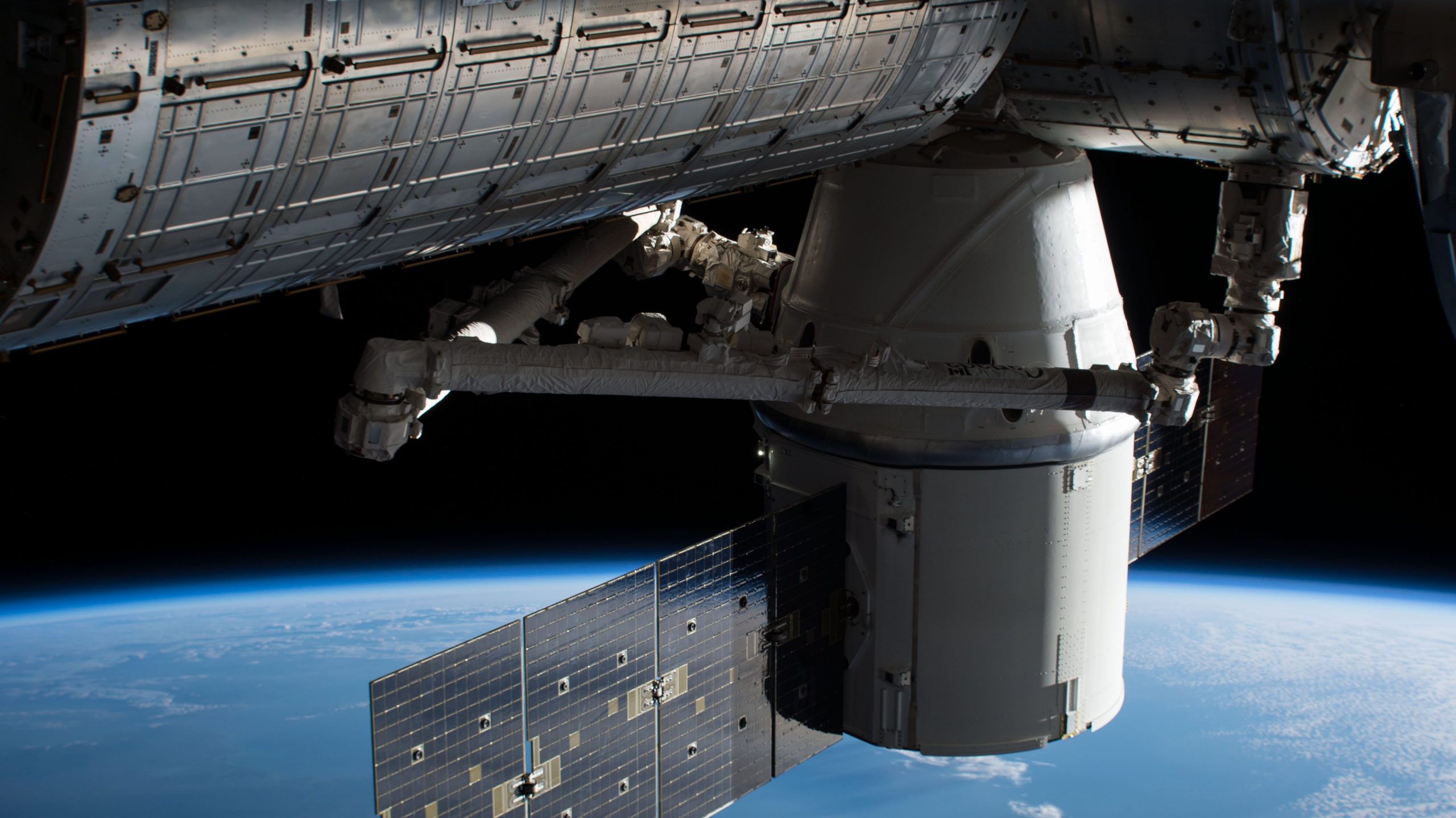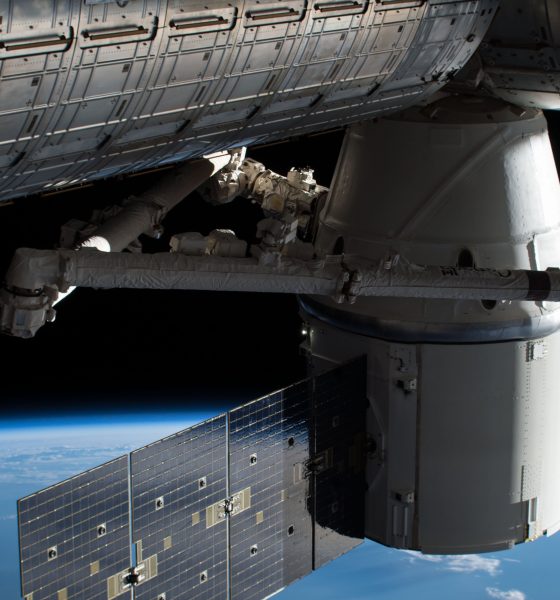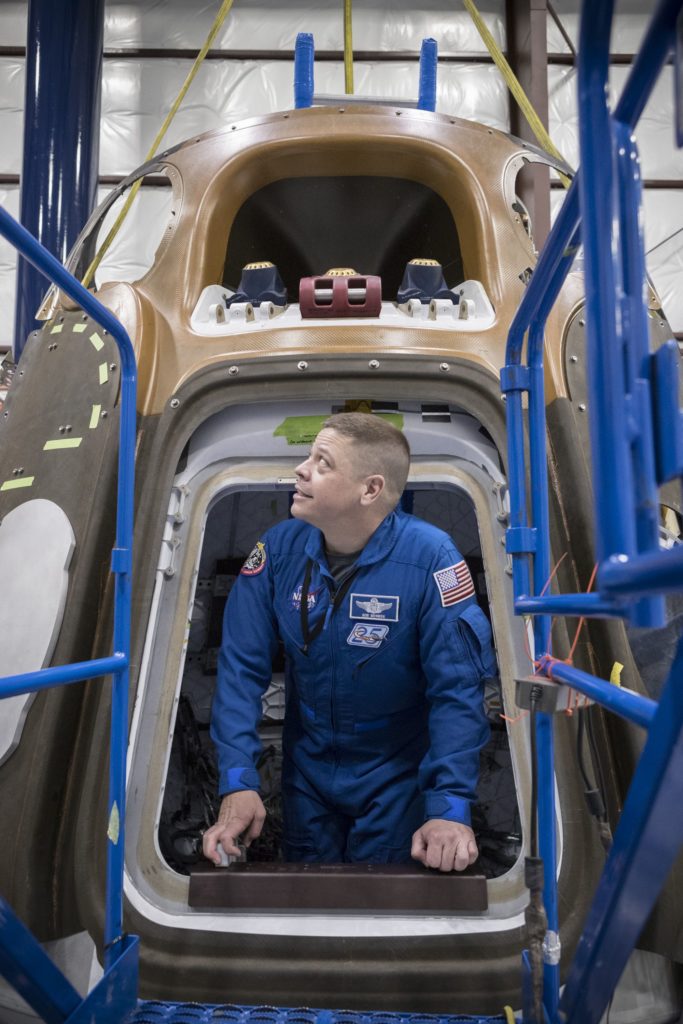

News
SpaceX teases Crew Dragon capsule and spacesuit details in new video
Over the past few weeks, conference presentations given by SpaceX employees like Joy Dunn and Paul Wooster have kicked off with an updated intro reel including unseen slow-motion footage of Falcon Heavy and detailed looks at the company’s spacesuit and Crew Dragon capsule.
Those in the habit of catching SpaceX launches live will be readily familiar with the company’s intro reel – it’s marked the start of live coverage for nearly every webcast in the past three or more years. The current intro reel has remained more or less unchanged since the first successful Falcon 9 booster recovery in December 2015, and this updated intro reel will be a breath of fresh air for what is still admittedly an amazing video. Still, it’s hard to say “no” to slow-motion footage of Falcon Heavy.
Most recently shown at an MIT Media Lab conference during SpaceX Principal Mars Development Engineer Paul Wooster’s presentation, the new reel has – somewhat unsurprisingly – been built around the incredibly successful inaugural Falcon Heavy launch, as well as some more recent footage of the company’s Cargo Dragon docking with the International Space Station. Additional clips show what appears to be details of the finalized Crew Dragon – set to debut in late 2018 – and a closeup of SpaceX’s internally-designed spacesuit. Sticking out as the only truly unusual snippet, the end of the new reel features parts of the animation SpaceX released in 2016 during the debut of their Mars rocket, the Interplanetary Transport System (ITS), which has since been replaced with the similar but different BFR.
While entirely possible that the inclusion of ITS footage in an intro reel clearly updated since 2018 is intentional, it seems more likely that SpaceX has yet to publicize this new video partially because they don’t yet have a similar animation featuring their updated Mars rocket and spaceship. CEO Elon Musk’s recent comments on the encouraging progress being made with the design and construction of the first BFR prototype suggests that such an updated animation could be just around the corner, if not full-up teaser photos of the construction progress. Set to begin suborbital hop testing as early as the first half of 2019 and orbital launches by end of 2020, SpaceX’s Mars ambitions may still feel far away, but the tech that could make them real is already undergoing preliminary construction and testing.
Sooner still is SpaceX’s upcoming debut of Crew Dragon, the spacecraft that will eventually both carry astronauts to the ISS and later replace Cargo Dragon. Initially intended to land near the launch pad on legs, akin to Falcon 9, SpaceX has since canceled that work, largely due to numerous delays that would have almost certainly been incurred in the process of NASA certification of such a new and unproven technology. Instead, Musk made it clear that SpaceX would instead put its time, energy, and money into the development of BFR and BFS, sidestepping NASA’s sometimes-smothering and counterproductive paternalism for the time being.
Crew Dragon will instead be recovered after landing in the ocean, a disappointing concession that is at least partially cushioned by SpaceX’s recent successes and growing expertise with the reuse of their similarly sea-recovered Cargo Dragons. While ocean-recovery certainly won’t lend itself to ease of reuse quite as readily as powered landings, SpaceX will likely be able to significantly drop the cost of Crew Dragon launches in the future by efficiently refurbishing each recovered capsule. Less likely but still a possibility, the company could adopt something similar to the fairing-catcher Mr Steven – essentially a giant net aboard a highly-maneuverable boat – to recover Crew Dragon without submerging the spacecraft in saltwater. As of March 2018, at least according to NASA’s Kennedy Space Center director, SpaceX is still on track to conduct its first uncrewed launch of Crew Dragon as early as August 2018, with the first crewed mission following in December 2018 if all goes well.
- ITS was much wider and taller than the updated BFR, making it considerably easier to develop. (SpaceX)
- BFR’s booster and spaceship, tiny human for scale. (SpaceX)
- Astronaut Bob Behnken emerges from the hatch of a SpaceX Crew Dragon spacecraft in manufacturing at SpaceX’s headquarters and factory in Hawthorne, CA. (SpaceX)
SpaceX’s spacesuit is a critical component of their crewed spaceflight efforts, and has been designed and built in-house to ensure that astronauts can survive the emergency depressurization of a Crew Dragon capsule, evidenced by Musk’s recent suggestions that senior suit engineers successfully survived stints in a vacuum chamber while wearing it. Thanks to the staggering success of Falcon Heavy and its iconic Starman and Tesla Roadster payload, SpaceX’s spacesuit will undoubtedly be a badge of honor for all future astronauts who fly aboard Crew Dragon.

Starman gives one final farewell to Earth as he departs for deep space aboard Musk’s Tesla Roadster. (SpaceX)

News
Tesla hints at Starlink integration with recent patent
“By employing polymer blends, some examples enable RF transmission from all the modules to satellites and other communication devices both inside and outside the vehicle.”

Tesla hinted at a potential Starlink internet terminal integration within its vehicles in a recent patent, which describes a vehicle roof assembly with integrated radio frequency (RF) transparency.
The patent, which is Pub. No U.S. 2025/0368267 describes a new vehicle roof that is made of RF-transparent polymer materials, allowing and “facilitating clear communication with external devices and satellites.”
Tesla believes that a new vehicle roof design, comprised of different materials than the standard metallic or glass elements used in cars today, would allow the company to integrate modern vehicular technologies, “particularly those requiring radio frequency transmission and reception.
Tesla has recently filed a US patent application on integrating RF transparent materials into the roof structure.
“facilitating clear communication with external devices and satellites”
Tesla fleet is getting @Starlink connectivity integration soon. LFG @Tesla @elonmusk… pic.twitter.com/bLa8YtPLd1
— Chansoo Byeon (@Chansoo) December 9, 2025
Instead of glass or metallic materials, Tesla says vehicles may benefit from high-strength polymer blends, such as Polycarbonate, Acrylonitrile Butadiene Styrene, or Acrylonitrile Styrene Acrylate.
These materials still provide ideal strength metrics for crashworthiness, stiffness for noise, vibration, and harshness control, and are compliant with head impact regulations.
They would also enable better performance with modern technologies, like internet terminals, which need an uninterrupted signal to satellites for maximum reception. Tesla writes in the patent:
“By employing polymer blends, some examples enable RF transmission from all the modules to satellites and other communication devices both inside and outside the vehicle.”

One of the challenges Tesla seems to be aware of with this type of roof design is the fact that it will still have to enable safety and keep that at the forefront of the design. As you can see in the illustration above, Tesla plans to use four layers to increase safety and rigidity, while also combating noise and vibration.
It notes in the patent that disclosed examples still meet the safety requirements outlined in the Federal Motor Vehicle Safety Standards (FMVSS).
Starlink integrated directly into Tesla vehicles would be a considerable advantage for owners. It would come with a handful of distinct advantages.
Initially, the inclusion of Starlink would completely eliminate cellular dead zones, something that is an issue, especially in rural areas. Starlink would provide connectivity in these remote regions and would ensure uninterrupted service during road trips and off-grid adventures.
It could also be a critical addition for Robotaxi, as it is crucial to have solid and reliable connectivity for remote monitoring and fleet management.
Starlink’s growing constellation, thanks to SpaceX’s routine and frequent launch schedule, will provide secure, stable, and reliable internet connectivity for Tesla vehicles.
Although many owners have already mounted Starlink Mini dishes under their glass roofs for a similar experience, it may be integrated directly into Teslas in the coming years, either as an upgrade or a standard feature.
News
Tesla supplements Holiday Update by sneaking in new Full Self-Driving version
It seems Tesla was waiting for the Hardware 4 rollout, as it wanted to also deploy a new Full Self-Driving version to those owners, as it appeared in the release notes for the Holiday Update last night.

Tesla has surprised some owners by sneaking in a new Full Self-Driving version with the wide release of the Holiday Update, which started rolling out to Hardware 4 owners on Friday night.
Tesla has issued a controlled and very slow release pattern with the Holiday Update, which rolls out with Software Version 2025.44.25.5.
For the past two weeks, as it has rolled out to Hardware 3 and older Tesla owners, the company has kept its deployment of the new Software Version relatively controlled.
It seems Tesla was waiting for the Hardware 4 rollout, as it wanted to also deploy a new Full Self-Driving version to those owners, as it appeared in the release notes for the Holiday Update last night.
Tesla Full Self-Driving v14.2.1.25 made its first appearance last night to Hardware 4 owners who are members of the Early Access Program (EAP). It appears to be a slight refinement from FSD v14.2.1, which has been out for a couple of weeks.
Tesla v2025.44.25.5 Holiday update incoming
Also Full Self-Driving v14.2.1.25!!! pic.twitter.com/74D7S0UGXz
— TESLARATI (@Teslarati) December 13, 2025
Many owners welcome the new FSD version, us included, because we’ve been less than impressed with v14.2.1. We have experienced some minor regressions with v14.2.1, especially with Speed Limit recognition, Speed Profile tinkering, and parking performance.
As it stands, Full Self-Driving is still particularly impressive, but Tesla is evidently having an issue with some of the adjustments, as it is still refining some of the performance aspects of the suite. This is expected and normal with some updates, as not all of them are an improvement in all areas; we routinely see some things backtrack every once in a while.
This new FSD version is likely to take care of those things, but it also includes all of the awesome Holiday Update features, which include:
- Grok with Navigation Commands (Beta) – Grok will now add and edit destinations.
- Tesla Photobooth – Take pictures inside your car using the cabin-facing camera
- Dog Mode Live Activity – Check on your four-legged friend on your phone through periodic snapshots taken of the cabin
- Dashcam Viewer Update – Includes new metrics, like steering wheel angle, speed, and more
- Santa Mode – New graphics, trees, and a lock chime
- Light Show Update – Addition of Jingle Rush light show
- Custom Wraps and License Plates – Colorizer now allows you to customize your vehicle even further, with custom patterns, license plates, and tint
- Navigation Improvements – Easier layout and setup
- Supercharger Site Map – Starting at 18 pilot locations, a 3D view of the Supercharger you’re visiting will be available
- Automatic Carpool Lane Routing – Navigation will utilize carpool lanes if enabled
- Phone Left Behind Chime – Your car will now tell you if you left a phone inside
- Charge Limit Per Location – Set a charge limit for each location
- ISS Docking Simulator – New game
- Additional Improvements – Turn off wireless charging pad, Spotify improvements, Rainbow Rave Cave, Lock Sound TRON addition
Tesla also added two other things that were undocumented, like Charging Passport and information on USB drive storage to help with Dashcam.
Cybertruck
Tesla updates Cybertruck owners about key Powershare feature

Tesla is updating Cybertruck owners on its timeline of a massive feature that has yet to ship: Powershare with Powerwall.
Powershare is a bidirectional charging feature exclusive to Cybertruck, which allows the vehicle’s battery to act as a portable power source for homes, appliances, tools, other EVs, and more. It was announced in late 2023 as part of Tesla’s push into vehicle-to-everything energy sharing, and acting as a giant portable charger is the main advantage, as it can provide backup power during outages.
Cybertruck’s Powershare system supports both vehicle-to-load (V2L) and vehicle-to-home (V2H), making it flexible and well-rounded for a variety of applications.
However, even though the feature was promised with Cybertruck, it has yet to be shipped to vehicles. Tesla communicated with owners through email recently regarding Powershare with Powerwall, which essentially has the pickup act as an extended battery.
Powerwall discharge would be prioritized before tapping into the truck’s larger pack.
However, Tesla is still working on getting the feature out to owners, an email said:
“We’re writing to let you know that the Powershare with Powerwall feature is still in development and is now scheduled for release in mid-2026.
This new release date gives us additional time to design and test this feature, ensuring its ability to communicate and optimize energy sharing between your vehicle and many configurations and generations of Powerwall. We are also using this time to develop additional Powershare features that will help us continue to accelerate the world’s transition to sustainable energy.”
Owners have expressed some real disappointment in Tesla’s continuous delays in releasing the feature, as it was expected to be released by late 2024, but now has been pushed back several times to mid-2026, according to the email.
Foundation Series Cybertruck buyers paid extra, expecting the feature to be rolled out with their vehicle upon pickup.
Cybertruck’s Lead Engineer, Wes Morrill, even commented on the holdup:
As a Cybertruck owner who also has Powerwall, I empathize with the disappointed comments.
To their credit, the team has delivered powershare functionality to Cybertruck customers who otherwise have no backup with development of the powershare gateway. As well as those with solar…
— Wes (@wmorrill3) December 12, 2025
He said that “it turned out to be much harder than anticipated to make powershare work seamlessly with existing Powerwalls through existing wall connectors. Two grid-forming devices need to negotiate who will form and who will follow, depending on the state of charge of each, and they need to do this without a network and through multiple generations of hardware, and test and validate this process through rigorous certifications to ensure grid safety.”
It’s nice to see the transparency, but it is justified for some Cybertruck owners to feel like they’ve been bait-and-switched.











